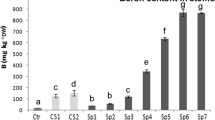Summary
p-Nitrophenol (PNP),m-nitrophenol (MNP), 2,4-dinitrophenol (DNP) and catechol were tested for their effects on algal population in a soil and on pure cultures of two algae isolated from soil. Both PNP and MNP, even at 0.5 kg ha−1 level were toxic to the soil algae; high doses effected increase in toxicity. Inhibition of algae was relatively more with PNP compared to the other two nitrophenols. Catechol treatment up to 1.0 kg ha−1 led to a significant initial enhancement of algae with a subsequent far less toxic effect.
The toxicity of the phenolic compounds towardChlorella vulgaris, a green alga andNostoc linckia, a blue-green alga, decreased in the order: MNP≧PNP>DNP>Catechol. However, algicidal or algistatic effect of the test chemicals was fairly more againstC. vulgaris, suggesting that the eukaryotic alga is highly sensitive to such soil pollutants compared to the prokaryotic alga.
Similar content being viewed by others
References
Adrien A (ed.) 1979 Selective Toxicity. John-Wiley and Sons, New York 136 p.
Allen M B and Arnon D I 1955 Studies on nitrogen-fixing blue-green algae. I. Growth and nitrogen fixation byAnabaena cylindrica Lenn. Plant Physiol. 30, 366–372.
Barik S, Siddaramappa R and Sethunathan N 1976 Metabolism of nitrophenols by bacteria isolated from parathion-amended flooded soil. Antonie Van Leeuwenhoek J. Microbiol. Serol. 42, 461–470.
Bischoff H N and Bold H C 1963 Some soil algae from enchanted rock and related algal species. Physological studies IV. Univ. Texas Publ. No. 6318, Austin, Texas.
Cheng H H, Haider K and Harper S S 1983 Catechol and Chlorocatechols in soil: Degradation and extractability. Soil Biol. Biochem. 15, 311–317.
Dagley S 1967 The microbial metabolism of phenolics.In Soil Biochemistry. Eds. A D McLaren and G H Peterson. pp 287–317.
Goulding K H and Ellis S 1981 The interaction of DDT with two species of water algae. Environ. Pollut. 25, 271–290.
Jackson M L 1971 Soil chemical Analysis. Prentice-Hall of India (Ltd), New Delhi.
Jensen A 1978 Chlorophylls and carotenoids.In Handbook of Phycological Methods II. Physiological and biochemical methods. Eds. J A Hellebust and J S Craigie. pp 60–70. Cambridge Univ. Press, Cambridge.
Mackinney G 1941 Absorption of light by chlorophyll solution. J. Biol. Chem. 140, 315–322.
Mitra D and Vaidyanathan C I 1982 Comparative phytotoxicity of nitrophenolic soil pollutants and their microbial metabolites to the growth of cucumber (Cucumis sativus L.) seedlings. Plant and Soil 69, 467–471.
Munnecke D M and Hsieh D P H 1974 Microbial decontamination of parathion andP-nitrophenol in aqueous media. Appl. Microbiol. 28, 212–217.
Munnecke D M 1976 Enzymatic hydrolysis of organophosphatic insecticides, a possible pesticide disposal method. Appl. Environ. Microbiol. 32, 7–13.
Muralikrishna P V G and Venkateswarlu K 1984 Effect of insecticides on soil algal population. Bull. Environ. Contam. Toxicol. 33, 241–245.
Ou L-T 1985 Methyl parathion degradation and metabolism in soil: Influence of high soil-water contents. Soil Biol. Biochem. 17, 241–243.
Raymond D G M and Alexander M 1971 Microbial metabolism and co-metabolism of nitrophenols. Pestic. Biochem. Physiol. 1, 123–130.
Safferman R S and Morris M E 1964 Growth characteristics of the blue-green algal virus LPP-1. J. Bacteriol. 88, 771–775.
Sethunathan N and Yoshida T 1972 Conversion of paranitrophenol by diazinon-degrading bacterium,Flavobacterium sp. Inst. Environ. Tech. Meet. Proc. 18, 255–257.
Stratton G W and Corke C T 1982 Toxicity of the insecticides and some degradation products towards algae and cyanobacteria. Environ. Pollut. 29, 71–80.
Walkley A and Black I A 1934 An examination of the Dijtjareff method of determining soil organic matter and a proposed modification of the chromic acid titration method. Soil Sci. 37, 29–39.
Woodcock D 1971 Metabolism of fungicides and nematicides in soils.In Soil Biochemistry vol II. Eds. A D McLaren and J. Skujins. pp 337–360. Marcel Dekker, N.Y.
Zeyer J and Kearney P C 1984 Degradation ofo-nitrophenol andm-nitrophenol by aPseudomonas putida. J. Agric. Food Chem. 32, 238–242.
Author information
Authors and Affiliations
Rights and permissions
About this article
Cite this article
Megharaj, M., Venkateswarlu, K. & Rao, A.S. The toxicity of phenolic compounds to soil algal population and toChlorella vulgaris andNostoc linckia . Plant Soil 96, 197–203 (1986). https://doi.org/10.1007/BF02374764
Received:
Revised:
Issue Date:
DOI: https://doi.org/10.1007/BF02374764




